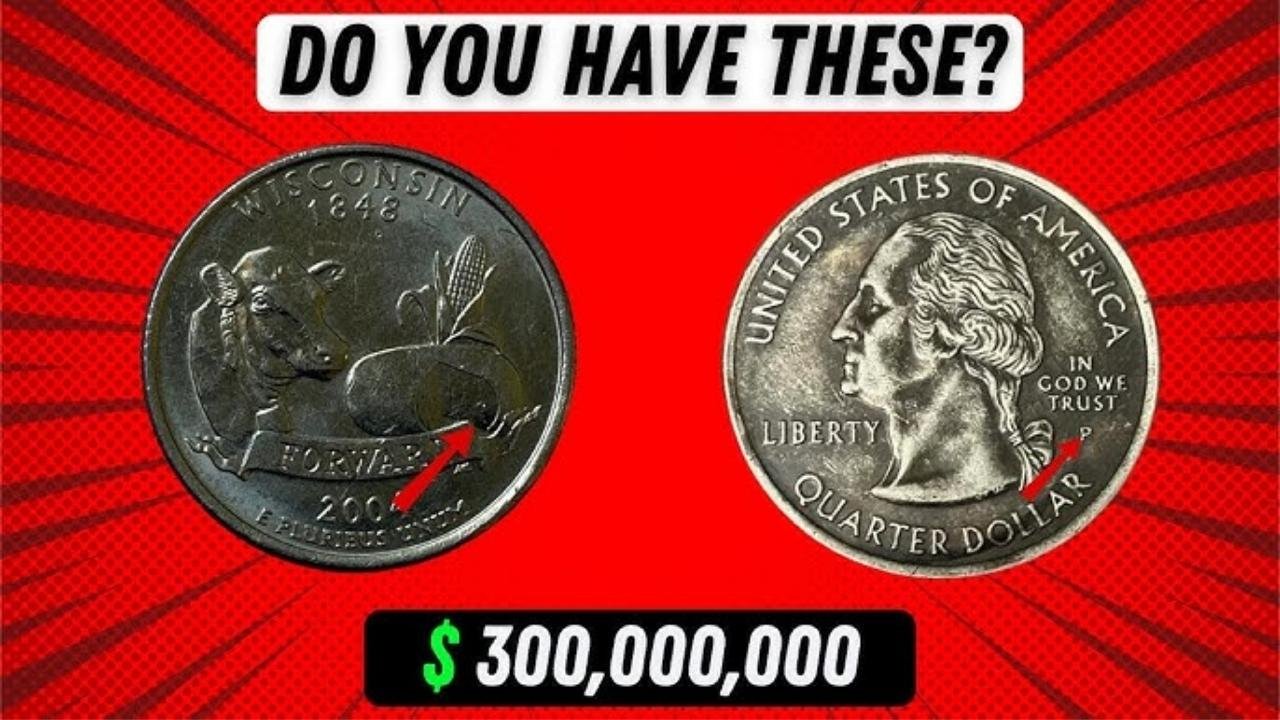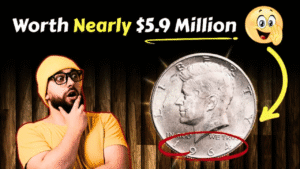Next time you fish a dime or quarter out of your pocket, take a closer look—it might be worth millions! Some rare U.S. coins, like the 1894-S Barber Dime or the 1976 Silver Bicentennial Quarter, have fetched jaw-dropping prices at auction, with collectors estimating their combined value at up to $455 million.
These treasures can still turn up in change jars, bank rolls, or old collections. Ready to strike it rich? Here are the top five rare dimes and quarters to look for, plus tips to spot them in your spare change!
Why Are Some Dimes and Quarters So Valuable?
Certain coins become collector’s gems due to rarity, minting errors, or historical significance. Low mintages, like the 1894-S Barber Dime’s mere 24 coins, make them scarce. Errors, like missing mint marks on 1975 No-S Roosevelt Dimes, create one-of-a-kind pieces.
Coins in pristine, uncirculated condition also command higher prices. Let’s dive into the five most valuable dimes and quarters you might find in circulation.
Top 5 Rare Dimes and Quarters to Look For
These coins are the holy grails of coin collecting. Check your change for these treasures!
1. 1894-S Barber Dime
The 1894-S Barber Dime is one of the rarest coins in the world. Only 24 were minted in San Francisco, with just nine known to exist today. Some believe they were made as gifts for bankers, others as test coins. In 2016, one sold for $1.9 million! Look for the year “1894” and a tiny “S” mint mark below the wreath on the reverse. Even a worn example could make you a fortune.
2. 1975 No-S Roosevelt Dime
This modern dime is a rare error coin. San Francisco-minted coins typically have an “S” mint mark, but a few 1975 dimes were struck without it. Only two are known to exist, and one sold for $456,000. Check your 1975 dimes near the date—if there’s no “S,” you might be holding a massive payday.
3. 1968 No-S Roosevelt Dime
Like the 1975 version, the 1968 No-S Roosevelt Dime lacks the expected “S” mint mark due to a minting error. Only a handful are known, and one fetched $400,000 at auction. Look for the year “1968” and confirm the absence of a mint mark near the date. This small mistake could mean big money.
4. 1916-D Mercury Dime
The 1916-D Mercury Dime, featuring a winged Liberty head resembling the Roman god Mercury, is a collector’s favorite. With only 264,000 minted in Denver, it’s highly sought after. A top-grade example can sell for over $100,000, with some nearing $1 million. Check for the year “1916” and a “D” mint mark near the bottom left of the olive branch on the reverse.
5. 1976 Silver Bicentennial Quarter
Minted to celebrate America’s 200th birthday, the 1976 Bicentennial Quarter features a drummer boy on the reverse and a “1776-1976” dual date. Most are worth 25 cents, but rare silver versions (struck on 40% silver planchets) or those with doubled die errors (blurry text in “LIBERTY” or “IN GOD WE TRUST”) can be worth up to $45 million in perfect condition. Check the edge for a solid silver color, not a copper stripe.
Value Table for Rare Dimes and Quarters
Here’s a quick guide to their approximate values:
| Coin | Mint Mark | Estimated Value | Why It’s Valuable |
|---|---|---|---|
| 1894-S Barber Dime | S | $500,000–$1.9M+ | Ultra-low mintage (24 coins) |
| 1975 No-S Roosevelt Dime | None | $100,000–$456,000+ | Missing mint mark error |
| 1968 No-S Roosevelt Dime | None | $50,000–$400,000+ | Missing mint mark error |
| 1916-D Mercury Dime | D | $1,000–$100,000+ | Low mintage, high demand |
| 1976 Silver Bicentennial Quarter | S or None | $500–$45M+ | Silver planchet or doubled die |
How to Spot These Coins in Your Change
Think you’ve got a rare coin? Here’s how to check:
- Check the Date and Mint Mark: Look for the year and mint mark (“S” for San Francisco, “D” for Denver, or none for Philadelphia). Key years are 1894, 1916, 1968, 1975, and 1976.
- Inspect for Errors: Use a magnifying glass to spot missing mint marks (1968/1975 No-S) or doubled text (1976 quarter). For the 1976 quarter, check the edge for silver.
- Weigh the Coin: Silver quarters (5.75 grams) are heavier than clad (5.67 grams). Dimes should weigh 2.27 grams (silver) vs. 2.5 grams (clad).
- Assess Condition: Pristine coins with sharp details and no wear are worth more. Never clean coins—it lowers their value.
- Research Rarity: Use sites like PCGS or NGC to check mintage numbers and auction records.
Tips for Protecting Your Coins
Found a potential treasure? Keep it safe:
- Don’t Clean: Cleaning removes the natural patina, reducing value.
- Store Properly: Use acid-free plastic holders or coin flips to prevent scratches.
- Handle Carefully: Use gloves or tweezers to avoid fingerprints.
- Get It Graded: Professional grading by PCGS or NGC confirms authenticity and boosts value.
Real-Life Examples of High-Value Sales
- 1894-S Barber Dime: Sold for $1.9 million in 2016 due to its ultra-low mintage.
- 1975 No-S Roosevelt Dime: Fetched $456,000 for its rare missing mint mark.
- 1976 Silver Bicentennial Quarter: A high-grade silver version sold for $19,200, with top estimates reaching $45 million for perfect examples.
How to Sell Your Rare Coin
Think you’ve found a valuable coin? Follow these steps:
- Verify Features: Compare your coin’s date, mint mark, and condition to known examples on PCGS or Heritage Auctions.
- Get It Authenticated: Have it graded by PCGS or NGC to confirm its authenticity and condition.
- Sell Smart: High-value coins sell best at auction houses like Heritage Auctions or Stack’s Bowers. For common coins, try local coin shops or eBay.
Why Hunt for Rare Dimes and Quarters?
Searching for these rare coins is like a treasure hunt in your everyday change. From the historic 1894-S Barber Dime to the modern 1976 Silver Bicentennial Quarter, these coins carry stories of minting mistakes and limited production. Finding one in your piggy bank or store change could mean a life-changing payday. So, grab your coins and start checking—you might just uncover a $455 million treasure!
FAQs About Rare Dimes and Quarters
Q: Why are some dimes and quarters so valuable?
A: Low mintages (e.g., 1894-S Barber Dime), minting errors (e.g., 1975 No-S Dime), and pristine condition drive their value, with some worth up to $45 million.
Q: How can I tell if my 1976 quarter is silver?
A: Check the edge for a solid silver color (no copper stripe) and weigh it—silver quarters are 5.75 grams, heavier than clad (5.67 grams).
Q: What makes the 1894-S Barber Dime so rare?
A: Only 24 were minted, with just nine known to exist, making it one of the rarest U.S. coins, valued up to $1.9 million.
Q: Can I find these rare coins in circulation?
A: Yes, though rare, these coins can still appear in change, bank rolls, or old collections.
Q: Where can I sell a rare dime or quarter?
A: High-value coins sell best at auction houses like Heritage Auctions or Stack’s Bowers. Common coins can go to coin shops or eBay.
Q: Should I clean my coin to make it look better?
A: No, cleaning damages the coin’s surface and lowers its value. Keep it untouched and consult a professional grader.




